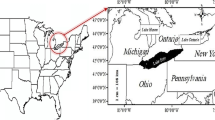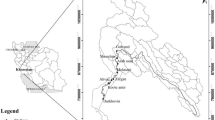Abstract
Rapid urbanization and global warming have caused a sequence of ecological issues in China including degradation of lake water environments which is one of the many consequences. Lakes are an important part of a biological system where a plethora of amphibian plants and animals reside. Other than this, they have a noteworthy impact in providing water for landscape irrigation, for domestic utilization, and most importantly sustaining a healthy ecosystem. Poyang Lake is the largest freshwater lake of China, with its rich water and biological resources for irrigation, water supply, shipping, and regulation of the flow; additionally, this lake can relieve the impact of droughts and floods by storing huge quantities of water and discharging it during shortages. However, the water environment is a standout among the most critical issues in Poyang Lake. This paper proposes two classification algorithms, i.e., classification and regression trees algorithm and particle swarm optimization + k-nearest neighbors algorithm to build up a connection between the water level and the primary water quality parameters of Poyang Lake. Two models have been trained with 8 years of data (2002~2008) and verified with 1 year of data (2009). Water quality forecasts from the particle swarm optimization + k-nearest neighbors algorithm was observed to be better when compared with the results obtained from the classification and regression trees algorithm. Finally, the category of the water quality was evaluated using 3 years of water level data (2010~2012) as an input to the particle swarm optimization + k-nearest neighbors algorithm.








Similar content being viewed by others
References
Breiman L (1996) Bagging predictors. Mach Learn 24(2):123–140
Breiman L, Friedman JH, Olshen RA, Stone CJ (1984) Classification and regression trees. Wadsworth & Brooks, Monterey
Cetin M (2015) Using GIS analysis to assess urban green space in terms of accessibility: case study in Kutahya. Int J Sustain Dev World Ecol 22(5):420–424
Cetin M (2016) Determination of bioclimatic comfort areas in landscape planning: a case study of Cide Coastline. Turkish JAF Sci Tech 4(9):800–804
Cetin M, Sevik H (2016) Measuring the impact of selected plants on indoor CO2 concentrations. Polish J Environ Stud 25(3):973–979
Cetin M, Onac AK, Sevik H, Canturk U, Akpinar H (2018a) Chronicles and geoheritage of the ancient Roman city of Pompeiopolis: a landscape plan. Arab J Geosci 11(24):798
Cetin M, Adiguzel F, Kaya O, Sahap A (2018b) Mapping of bioclimatic comfort for potential planning using GIS in Aydin. Environ Dev Sustain 20(1):361–375
Cetin M, Sevik H, Yigit N (2018c) Climate type-related changes in the leaf micromorphological characters of certain landscape plants. Environ Monit Assess 190(7):404
Cetin M, Zeren I, Sevik H, Cakir C, Akpinar H (2018d) A study on the determination of the natural park’s sustainable tourism potential. Environ Monit Assess 190(3):167
Coops H, Beklioglu M, Crisman TL (2003) The role of water-level fluctuations in shallow lake ecosystems - workshop conclusions. Hydrobiol 506(1–3):23–27
Cover T, Hart P (1967) Nearest neighbour pattern classification. IEEE Trans Inf Theory 13(1):21–27
Eberhart R, Kennedy J (1995) A new optimizer using particle swarm theory (ed) Micro Machine and Human Science, Proceedings of the Sixth International Symposium. pp 39–43
Gu P, Wan J (2011) Hydrology character of Poyang Lake and its influence on water quality. Environ Pollut Control 33:15–19
Guo H, Hu Q, Zhang Q, Feng S (2012) Effects of the three gorges dam on Yangtze river flow and river interaction with Poyang Lake, China: 2003–2008. J Hydrol 416:19–27
Hancock T, Put R, Coomans D, Vander Heyden Y, Everingham Y (2005) A performance comparison of modern statistical techniques for molecular descriptor selection and retention prediction in chromatographic QSRR studies. Chemom Intell Lab Syst 76(2):185–196
Hui J, Yao L (2016) Analysis and inversion of the nutritional status of China’s Poyang Lake using MODIS data. J Indian Soc Remote 44(5):837–842
Hwang WJ, Wen KW (1998) Fast KNN classification algorithm based on partial distance search. Electron Lett 34(21):2062–2063
Inthajak K, Duanggate C, Uyyanonvara B, Makhanov SS, Barman S (2011) Medical image blob detection with feature stability and KNN classification. In: Computer Science and Software Engineering (JCSSE), 2011 Eighth International Joint Conference on (pp 128–131)
Jin GH, Xie DM, Deng HB, Yan Y, Lin MY, Wang Y (2011) On seasonal hydrographic variety and environmental capacity of Poyang Lake. Acta Agric Univ Jiangxiensis 33(2):388–393
Kaya E, Agca M, Adiguzel F, Cetin M (2018) Spatial data analysis with R programming for environment. Hum Ecol Risk Assess Int J 1–10
Khan MYA, Tian F (2018) Understanding the potential sources and environmental impacts of dissolved and suspended organic carbon in the diversified Ramganga River, Ganges Basin, India. Proc Intl Assoc Hydrol Sci 379:61–66
Khan MYA, Gani KM, Chakrapani GJ (2016a) Assessment of surface water quality and its spatial variation. A case study of Ramganga River, Ganga Basin, India. Arab J Geosci 9(1)
Khan MYA, Khan B, Chakrapani GJ (2016b) Assessment of spatial variations in water quality of Garra River at Shahjahanpur, Ganga Basin, India. Arab J Geosci 9(8)
Khan MYA, Gani KM, Chakrapani GJ (2017) Spatial and temporal variations of physicochemical and heavy metal pollution in Ramganga River—a tributary of River Ganges, India. Environ Earth Sci 76(5):231
Lewis SL, Maslin MA (2015) Defining the anthropocene. Nature 519(7542):171–180
Li X, Xiang C (2012) Correlation-based K-nearest neighbor algorithm (ed) Software Engineering and Service Science (ICSESS), 2012 IEEE 3rd International Conference. pp 185–187
Li B, Yang G, Wan R, Zhang Y, Dai X, Chen Y (2016) Spatiotemporal variability in the water quality of Poyang Lake and its associated responses to hydrological conditions. Water 8(7):296
Liu J, Diamond J (2005) China’s environment in a globalizing world. Nature 435(7046):1179–1186
Meissner M, Schmuker M, Schneider G (2006) Optimized Particle Swarm Optimization (OPSO) and its application to artificial neural network training. BMC Bioinformatics 7:125
Mishra S, Kumar A, Shukla P (2016) Study of water quality in Hindon River using pollution index and environmetrics, India. Desalin Water Treat 57(41):19121–19130
Persic V, Horvatic J, Has-Schön E, Bogut I (2009) Changes in N and P limitation induced by water level fluctuations in Nature Park Kopacki Rit (Croatia): nutrient enrichment bioassay. Aquat Ecol 43(1):27–36
Ravichandran S (2003) Hydrological influences on the water quality trends in Tamiraparani Basin, South India. Environ Monit Assess 87(3):293–309
Smith VH, Schindler DW (2009) Eutrophication science: where do we go from here? Trends Ecol Evol 24(4):201–207
Sun S, Chen H, Ju W, Song J, Zhang H, Sun J, Fang Y (2013) Effects of climate change on annual streamflow using climate elasticity in Poyang Lake Basin, China. Theor Appl Climatol 112(1–2):169–183
Vandenbergh F, Engelbrecht A (2006) A study of particle swarm optimization particle trajectories. Inf Sci 176(8):937–971
Wang H, Zhou Y, Tang Y, Wu M, Deng Y (2015) Fluctuation of the water environmental carrying capacity in a huge river-connected lake. Int J Environ Res Public Health 12(4):3564–3578
Wang X, Wang W, Jiang W, Jia K, Rao P, Lv J (2018) Analysis of the dynamic changes of the Baiyangdian Lake surface based on a complex water extraction method. Water 10(11):1616
Wantzen KM, Rothhaupt KO, Mörtl M, Cantonati M, László G, Fischer P (2008) Ecological effects of water-level fluctuations in lakes: an urgent issue. Hydrobiol 613(1):1–4
Weinberger KQ, Saul LK (2009) Distance metric learning for large margin nearest neighbor classification. J Mach Learn Res 10(Feb):207–244
White MS, Xenopoulos MA, Hogsden K, Metcalfe RA, Dillon PJ (2008) Natural lake level fluctuation and associated concordance with water quality and aquatic communities within small lakes of the Laurentian Great Lakes region. Hydrobiol 613(1):21–31
Acknowledgements
The authors would like to thank Hydrology Bureau of Jiangxi Province for providing the hydrology data. The authors gratefully acknowledge the comments of the reviewers and the editor, which enormously improved the presentation of the manuscript.
Funding
This research was funded by the Ministry of Science and Technology of P.R. China (2016YFC0402701), the National Science Foundation of China (NSFC 91647205, 51190092, 51369011), the foundation of State Key Laboratory of Hydroscience and Engineering of Tsinghua University (2016-KY-03), science and technology project of the Jiangxi Provincial Department of Water Resources (KT201707).
Author information
Authors and Affiliations
Corresponding author
Additional information
Editorial handling: Broder J. Merkel
Rights and permissions
About this article
Cite this article
Li, Y., Khan, M.Y.A., Jiang, Y. et al. CART and PSO+KNN algorithms to estimate the impact of water level change on water quality in Poyang Lake, China. Arab J Geosci 12, 287 (2019). https://doi.org/10.1007/s12517-019-4350-z
Received:
Accepted:
Published:
DOI: https://doi.org/10.1007/s12517-019-4350-z




